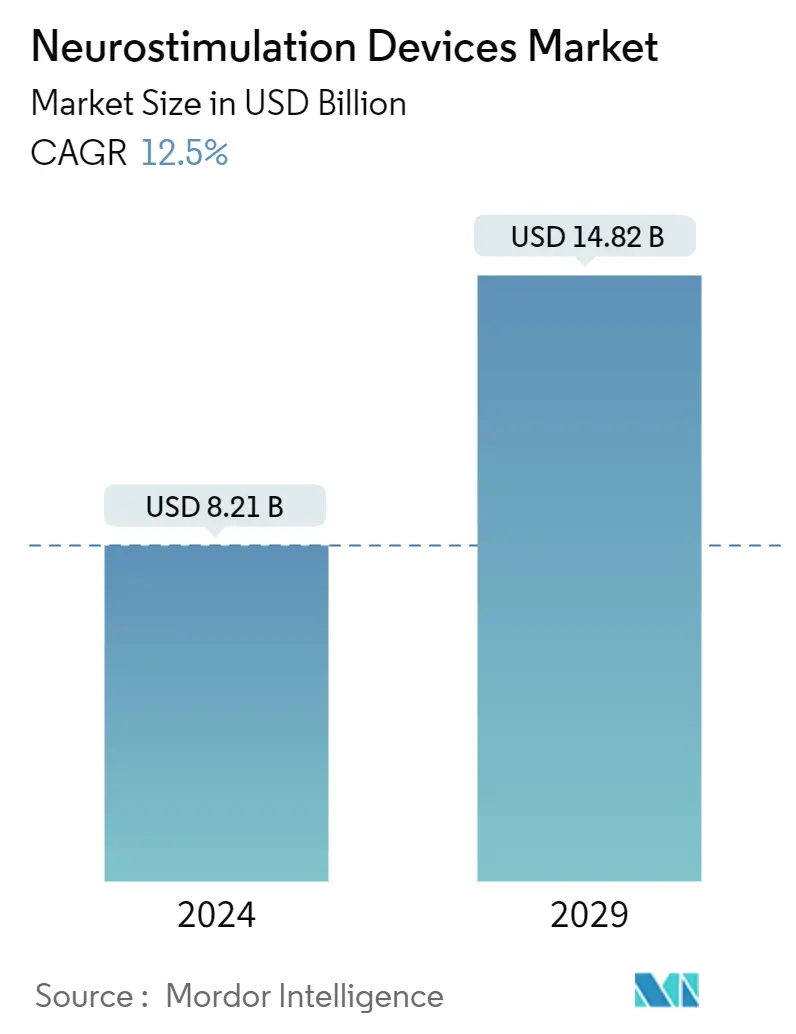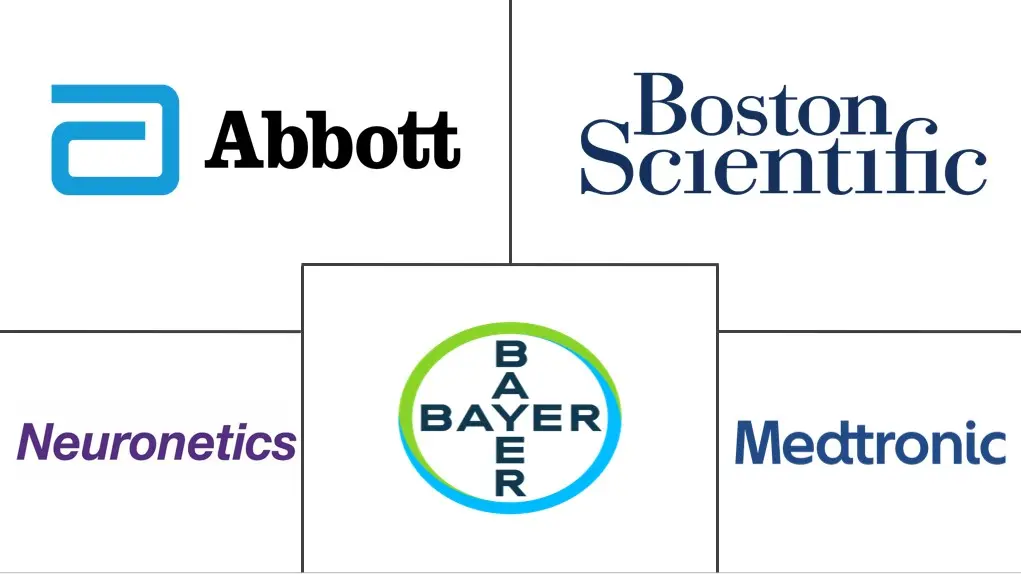Market Size of Neurostimulation Devices Industry

| Study Period | 2019 - 2029 |
| Market Size (2024) | USD 8.21 Billion |
| Market Size (2029) | USD 14.82 Billion |
| CAGR (2024 - 2029) | 12.50 % |
| Fastest Growing Market | Asia-Pacific |
| Largest Market | North America |
| Market Concentration | Low |
Major Players
*Disclaimer: Major Players sorted in no particular order |
Neurostimulation Devices Market Analysis
The Neurostimulation Devices Market size is estimated at USD 8.21 billion in 2024, and is expected to reach USD 14.82 billion by 2029, growing at a CAGR of 12.5% during the forecast period (2024-2029).
Factors such as the rising prevalence of neurological disorders and the technological advancements in neurostimulation devices are expected to bolster market growth over the forecast period. For instance, according to the September 2022 report of the World Health Organization, about 55 million people around the world had dementia, and nearly 10 million cases were reported annually. Thus, with the rise in the prevalence of neurological diseases, the demand for neurostimulation devices is expected to increase, which is anticipated to impact the growth of the market. Furthermore, according to the Primary Care Dementia Data, published in January 2023 by NHS, 7,355 males and 6,693 females aged 65 and above were reported to have dementia in England in January 2023. Thus, owing to the high incidence of neurological diseases, the demand for neurostimulation devices is expected to rise, fuelling market growth over the forecast period.
An increase in strategic activities by the key players, such as product launches and collaborations, and a surge in product approvals by regulatory authorities bolsters market growth. For instance, in January 2022, TensCare showcased its latest in transcutaneous electrical nerve stimulation widely used for drug-free pain relief in the long-term treatment of chronic pain conditions such as diabetic neuropathy, backache, sciatica, osteoarthritis and the relief of the acute pain of childbirth at Arab Health 2022.
Similarly, in November 2022, ElectroCore Inc., a commercial-stage bioelectronic medicine company, received a Unique National Product Code Number from the Belgian Pharmaceutical Association for its gammaCore Sapphire non-invasive vagus nerve stimulator (nVNS). Further, in August 2022, Medtronic Private Limited launched the SenSight directional lead system for Deep Brain Stimulation (DBS) therapy to treat symptoms associated with movement disorders and epilepsy in India. Deep brain stimulation (DBS) is a treatment for symptoms of Parkinson's disease, including tremors, stiffness, and trouble walking.
Thus, owing to the increase in neurological diseases and strategic activities by the key players, the market is expected to witness significant growth over the forecast period. However, factors such as the complications associated with neurostimulation devices and stringent device approval regulations are expected to restrain the market growth during the forecast period.
Neurostimulation Devices Industry Segmentation
As per the report's scope, neurostimulation is the electrical process of inhibition, stimulation, modification, regulation, or therapeutic alteration of activity in the central, peripheral, or autonomic nervous systems. The device that generates the electrical impulses are considered neurostimulation devices.
The neurostimulation devices market is segmented by device type, application, end user, and geography. By device type, the market is segmented into implantable devices and external devices. By application, the market is segmented into Parkinson's disease, epilepsy, depression, dystonia, pain management, and others. By end user, the market is segmented into clinics, hospitals, and rehabilitation centers. By geography, the market is segmented into North America, Europe, Asia-Pacific, the Middle East and Africa, and South America. The report also covers the estimated market sizes and trends for 17 countries across major regions globally. The report offers the value (USD) for all the above segments.
| By Device Type | ||||||||
| ||||||||
|
| By Application | |
| Parkinson's Disease | |
| Epilepsy | |
| Depression | |
| Dystonia | |
| Pain Management | |
| Other Applications |
| By End-Users | |
| Clinics | |
| Hospitals | |
| Rehabilitation Centers |
| Geography | ||||||||
| ||||||||
| ||||||||
| ||||||||
| ||||||||
|
Neurostimulation Devices Market Size Summary
The neurostimulation devices market is poised for substantial growth, driven by the increasing prevalence of neurological disorders and advancements in technology. The rising incidence of conditions such as dementia and Parkinson's disease is expected to significantly boost the demand for neurostimulation devices. This demand is further supported by strategic activities from key industry players, including product launches, collaborations, and regulatory approvals, which are enhancing the availability and adoption of these devices. Despite the promising growth trajectory, the market faces challenges such as complications associated with neurostimulation devices and stringent regulatory requirements, which could potentially hinder its expansion.
The spinal cord stimulators segment is anticipated to experience notable growth due to the rising prevalence of spinal cord injuries and chronic pain conditions. The introduction of technologically advanced products and regulatory approvals for new devices are expected to further propel this segment. North America is projected to witness healthy growth, fueled by a growing geriatric population and a high incidence of neurological disorders. The market is characterized by fragmentation, with numerous companies employing strategies like acquisitions, partnerships, and investments in research and development to maintain competitive positions. Key players in the market include Abbott, Medtronic, and Boston Scientific Corporation, among others, who are actively involved in launching innovative products and expanding their market presence.
Neurostimulation Devices Market Size - Table of Contents
-
1. MARKET DYNAMICS
-
1.1 Market Overview
-
1.2 Market Drivers
-
1.2.1 Rise in Prevalence of Neurological Disorders
-
1.2.2 Technological Advancements in Neurostimulation Devices
-
-
1.3 Market Restraints
-
1.3.1 Complications Associated with Neurostimulation Devices
-
1.3.2 Stringent Device Approval Regulations
-
-
1.4 Porter's Five Forces Analysis
-
1.4.1 Bargaining Power of Buyers/Consumers
-
1.4.2 Bargaining Power of Suppliers
-
1.4.3 Threat of New Entrants
-
1.4.4 Threat of Substitute Products
-
1.4.5 Intensity of Competitive Rivalry
-
-
-
2. MARKET SEGMENTATION (Market Size by Value - USD)
-
2.1 By Device Type
-
2.1.1 Implantable Devices
-
2.1.1.1 Spinal Cord Stimulators
-
2.1.1.2 Deep Brain Stimulators
-
2.1.1.3 Sacral Nerve Stimulators
-
2.1.1.4 Vagus Nerve Stimulators
-
2.1.1.5 Gastric Electric Stimulators
-
2.1.1.6 Other Device Types
-
-
2.1.2 External Devices
-
2.1.2.1 Transcranial Magnetic Stimulation (TMS)
-
2.1.2.2 Transcutaneous Electrical Nerve Stimulation (TENS)
-
2.1.2.3 Other External Devices
-
-
-
2.2 By Application
-
2.2.1 Parkinson's Disease
-
2.2.2 Epilepsy
-
2.2.3 Depression
-
2.2.4 Dystonia
-
2.2.5 Pain Management
-
2.2.6 Other Applications
-
-
2.3 By End-Users
-
2.3.1 Clinics
-
2.3.2 Hospitals
-
2.3.3 Rehabilitation Centers
-
-
2.4 Geography
-
2.4.1 North America
-
2.4.1.1 United States
-
2.4.1.2 Canada
-
2.4.1.3 Mexico
-
-
2.4.2 Europe
-
2.4.2.1 Germany
-
2.4.2.2 United Kingdom
-
2.4.2.3 France
-
2.4.2.4 Italy
-
2.4.2.5 Spain
-
2.4.2.6 Rest of Europe
-
-
2.4.3 Asia-Pacific
-
2.4.3.1 China
-
2.4.3.2 Japan
-
2.4.3.3 India
-
2.4.3.4 Australia
-
2.4.3.5 South Korea
-
2.4.3.6 Rest of Asia-Pacific
-
-
2.4.4 Middle East and Africa
-
2.4.4.1 GCC
-
2.4.4.2 South Africa
-
2.4.4.3 Rest of Middle East and Africa
-
-
2.4.5 South America
-
2.4.5.1 Brazil
-
2.4.5.2 Argentina
-
2.4.5.3 Rest of South America
-
-
-
Neurostimulation Devices Market Size FAQs
How big is the Neurostimulation Devices Market?
The Neurostimulation Devices Market size is expected to reach USD 8.21 billion in 2024 and grow at a CAGR of 12.5% to reach USD 14.82 billion by 2029.
What is the current Neurostimulation Devices Market size?
In 2024, the Neurostimulation Devices Market size is expected to reach USD 8.21 billion.

